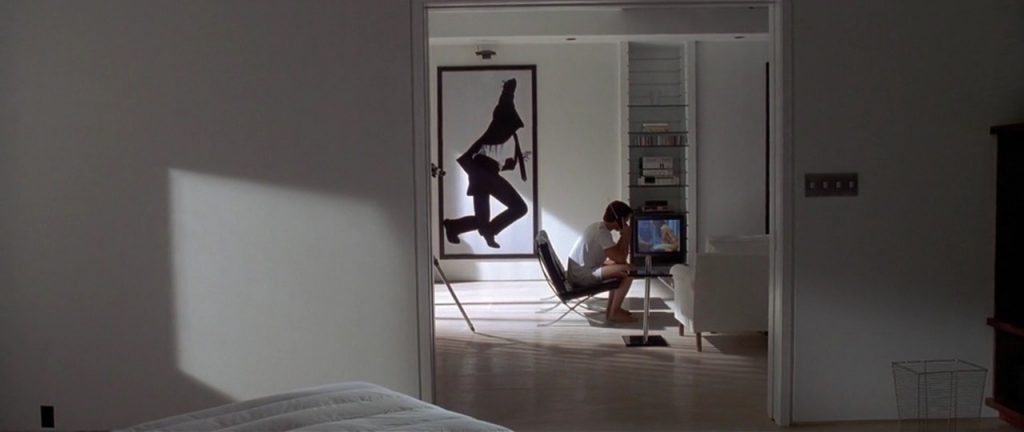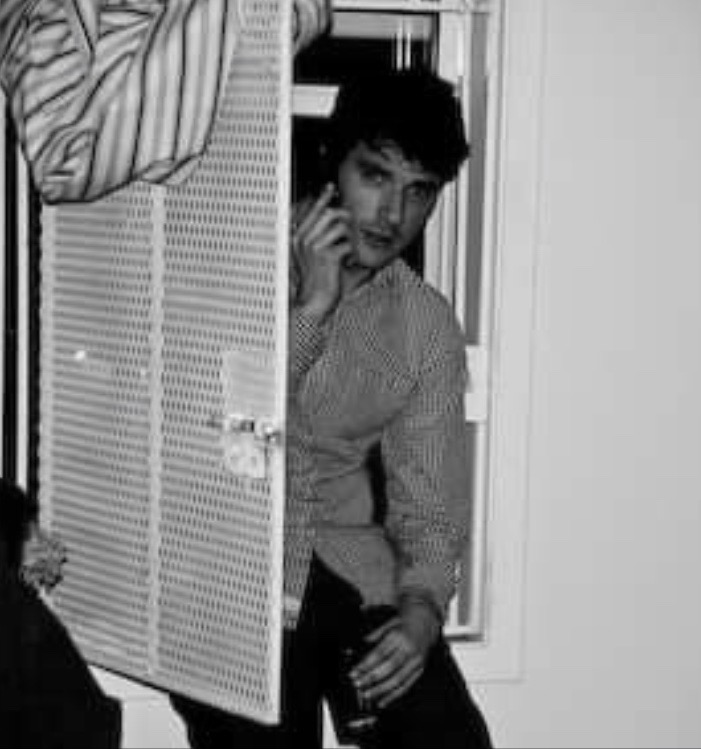The Art of Showbiz
Keanu Reeves in Johnny Mnemonic (1996, Tri- Star Pictures).
From subculture to superculture with Dennis Hopper, Johnny Mnemonic, and the Pictures Generation
In the 1990s — when up-and-coming artists still considered selling out as something to be avoided, and the boundaries between sub- and superculture were porous as ever — a handful of New York City artists from what writer-curator Douglas Crimp termed the “Pictures Generation” would try their hand at Hollywood, or Hollywood-adjacent, filmmaking.
It’s a story as old as showbiz itself: a critically acclaimed artiste relocates to the sequoia’d palms of Hollywood to direct their first big studio release, only to find their creative ambitions ground to a fine dust by bureaucratic infighting, clueless executives and the demands of working within a system biased against everything an individual artist stands for. This isn’t to say that no blood was drawn from the Pictures Generation’s opportunistic stab at the mainstream. Quite the opposite, in fact.
Backtrack (1990)
Aside from Kathryn Bigelow (who collaborated with artists like Richard Serra, Laurence Weiner and feminist auteur Lizzie Borden, before going on to make artillery-worshipping hits like Point Break and Zero Dark Thirty), the phantom haunting this informal survey is probably Dennis Hopper. While not a member of the Pictures Generation (too old, too West Coast), Hopper spent his storied career straddling the backlot and fine-art milieux as patron, performer, and mastermind.
Following an Oscar nomination for 1986’s Hoosiers and rave reviews for helming the LAPD drama Colors, Hopper rigged up a magnum opus called Backtrack with Vestron Pictures, starring himself as an assassin named Milo who becomes obsessed with a young “Cindy Sherman-type artist-entrepreneur” named Anne Benton (Jodie Foster) after she witnesses one of his hits go down. The production spiraled out of control and the producers commissioned a borderline-incoherent cut called Catchfire, which Hopper took his name off of. The twist is that Anne is unabashedly based on the conceptual artist Jenny Holzer, whose signature LED panels — scrolling ominous phrases such as MURDER HAS ITS SEXUAL SIDE, EVEN YOUR FAMILY CAN BETRAY YOU and the iconic ABUSE OF POWER COMES AS NO SURPRISE — factor heavily into the film.
Backtrack is that rare film maudit that grows weirder and weirder the more research you put into it. The director’s cut features Bob Dylan as a chainsaw-wielding artist standing in for either Frank Stella or Laddie Dill (depending who you ask), framed against a backdrop of work by the great wall-relief painter Charles Arnoldi. Given Anne’s voluntary (!) decision to become Milo’s love-slave, Hopper’s real-life fixation on the Taos, New Mexico location where much of Backtrack was shot, and the brain-breaking list of cameos from his extended creative circle, it seems likely his motivations were classic ones: vanity, wish-fulfillment, and challenging Hollywood philistinism by siphoning money to his friends. (Joe Pesci, Fred Ward, John Turturro, Dean Stockwell, Charlie Sheen, Catherine Keener, Vincent Price, and Neil Young all appear in speaking parts of varying sizes.)
Super Mario Bros. (1993)
A few years later, Hopper would star as King Koopa in Super Mario Bros. — widely regarded as one of the worst movies ever made, directed under intense studio pressure by British video artists Annabel Jankel and Rocky Morton (co-creators of the original Max Headroom). While today’s summer tentpoles are committee-arbited down to the last frame, Super Mario Bros. represents a serious but compromised attempt — alternatively slap-happy and saccharine, yet filled with disgusting and surreal images — to give a dark reinterpretation to the most popular video game of all time.
Johnny Mnemonic (1996)
A less telling, similarly doomed example is the would-be summer blockbuster Johnny Mnemonic, written by William Gibson and directed by NYC-based fine artist Robert Longo. As recounted by scholar Vera Dika in her excellent The (Moving) Pictures Generation, feature filmmaking was a pinnacle yearned after by Longo — already famous for the armies of assistants and technicians bringing his performances and paintings to life — since the beginning of his career.
Longo’s most famous work is arguably Men in the Cities, a series of dazzling charcoal and graphite drawings of contorting bodies isolated in space, redrawn from photographs he shot on the roof of his downtown loft between 1977 and 1983. Featuring the flailing limbs of Cindy Sherman, stand-up monologist Eric Bogosian and other downtown personalities (some of whom would feature in Longo’s 1987 anthology-short film Arena Brains) the shots harken back to the hard edges of modern dance, and the ubiquitous film noirs and cop procedurals that were a TV mainstay of many Boomer childhoods: its subjects appear frozen at the moment of impact, a smoking gun perhaps just off-frame.
(In a sly comment on the Reagan-era symbiosis between high art and higher finance, Mary Harron’s film adaptation of Bret Easton Ellis’s American Psycho saw Men in the Cities hanging on the walls of Patrick Bateman’s penthouse apartment. The drawings later served as de facto inspiration for Apple’s first iTunes ad campaign before completing their circuit in a mini-remake by Longo at the behest of Bottega Veneta — bringing back the original silhouettes, plus luxury brand handbags.)

One of the many appearances by Men in the Cities in Marry Harron’s American Psycho (2000, Lion’s GateFilms).
Johnny Mnemonic’s most zealous defenders cite it as an act of subterfuge, a punk refusal to play by the rules of the system, and a tantalizing glimpse at the possibilities of digital technology in a pre-Matrix landscape. In an interview with Wired before the film’s release, Longo and Gibson bemoaned the co-opting of the grunge movement out of Seattle, and the director alluded to his difficulties with Columbia TriStar brass as follows: “We did a good job! They gave us $30 million and we gave them a movie they don’t understand!”
The film does feature many inspired touches: Nilo Rodis-Jamero’s production design is staggering, Dolph Lundgren plays a Jesus freak remake of Roy Batty from Blade Runner, Japanese auteur Takeshi “Beat” Kitano is the main villain, and the climax involves a clairvoyant, cybernetic dolphin. If Longo and Gibson were angling to subvert the Hollywood tentpole, there’s little evidence that they succeeded: the movie walks an uncomfortable line between knowingly deadpan and painfully anemic. It’s often hard to tell what is a sincere prediction versus an aggressive stylistic choice, but this tension is one of the most thrilling things about the movie.
Search and Destroy (1995)
On the Indiewood side, revered neo-Expressionist painter David Salle took to filmmaking with Search and Destroy, starring Griffin Dunne as Martin Mirkheim, a would-be con man who turns to filmmaking during a midlife crisis, setting his sights on adapting a mythical self-help book written by a bogus motivational speaker named Dr. Waxling (played, of course, by Dennis Hopper.)
Adapted by filmmaker Michael Almeredeya (Nadja) from a play by Howard Korder (This Boy’s Life), and produced by none other than Martin Scorsese (who has a delicious cameo as Martin’s bookkeeper), the film is a queasily self-reflexive anti-comedy who’s-who of downtown NYC cool, just a few years past prime. Martin turns to selling drugs with the help of a magnate played by Christopher Walken, who describes himself as doing “market analysis for Pacific Rim groups – robot systems, medical equipment and information retrieval, sexy stuff like that”.
Costing $1 million, the film foregrounds work by muralist Thomas Hart Benton and painter Alex Katz, a contemporary of Salle and Longo; Walken does a Brechtian number in a Japanese nightclub, and John Turturro plays an hysterical agent; characters dress in shoulder-padded Armani suits at all times. Search and Destroy isn’t a fiasco, but watching it means straining to understand Salle’s choices, less in a judgmental sense than an aesthetic one.
While Martin claims that what he really wants is to make “capital-A” art, his hustle goes unproduced; meanwhile, he has a fling with Waxling’s assistant (the great Illeana Douglas) that proves her ticket to the big time, making a gross-out horror thriller called Dead World. (What we see of that film in Search and Destroy is taken from Glenn Takajian and Ted Bohus’ underrated Metamorphosis: The Alien Factor.) Salle told New York Magazine that he pitched the film to Scorsese as a “flat Sixties pop art movie”; running afoul of perhaps-inevitable Tarantino comparisons, he frustratedly cited Buñuel and Dali as his inspirations instead.
Basquiat (1996)
Beyond the backgrounds of the filmmakers, what really binds these movies is the search for discernible traces of auteurism across mediums. Sometimes it’s possible to come across as too much of an auteur — which brings us to Julian Schnabel’s Basquiat ($5 million), starring Jeffrey Wright alongside both Walken and Hopper, as well as sundry other NYC scene fixtures. While the film has many moments of breathtaking, lumpen poetry (in no small part due to Wright’s underrated performance), Schnabel couldn’t stop himself from featuring Gary Oldman as “Albert Milo”, an obvious stand-in for the filmmaker by which he embellishes his friendship with the tortured young artist.
In her New York Times review, Roberta Smith — who once groan-inducingly rebranded Longo as “Robert Long-Ago” — knocked Schnabel for omitting many of Basquiat’s contemporaries, including Keith Haring, Kenny Scharf, George Condo, and Francesco Clemente, and for pointlessly inserting a thinly silkscreened version of himself as a young man into the action. (Smith was more generous toward Search and Destroy, which she claimed had “the brittle self-consciousness and sophistication of Salle’s paintings”.)
Office Killer (1997)
The final film in this dream-retrospective is Cindy Sherman’s Office Killer, a macabre comedy starring Carol Kane as Dorine, a mousy copyeditor forced to work from home due to budget cuts at her magazine. Her coworkers are uniformly selfish, hateful people; Dorine declines to call 911 after one of them electrocutes himself trying to fix a PC (the decline of print and onset of digital work culture being one of the animating anxieties of Sherman’s film). What results is a slow-burn killing spree connected to Dorine’s long-suppressed trauma from childhood, a series of flashbacks skillfully rendered by Sherman in the hues of William Eggleston’s 1970s photography and her own famous self-portraiture.
Office Killer was too obscure to catch on with any kind of general public, yet too incisive and crass to win acclaim from professional snobs (the more familiar you are with Sherman’s more famous work, the more satisfying it will be). This exposes another paradox: any film costing more than a few thousand dollars will require extensive proofing-of-concept to get green-lit and distributed, so the industry defaults to punishing outside-the-box concepts.
What price glory?
In that same New York Magazine feature story quoting Salle, Longo mused, ahead of Johnny Mnemonic’s release, that he had been “accused of being too pop for the art world and too smart for the real world”. If the end product failed in all applicable directions, there’s still something admirable in that any of these experiments were finished and released at all.
Hollywood has always run on recycled ideas, but in the current moment, imagining an artist of Longo’s stature being entrusted with any of today’s massive genre properties isn’t just a stretch; it’s insanity. Salle, Longo and Sherman’s contemporaries who stayed at the other end of the filmmaking food chain — toiling in an endlessly corporatized New York City to make zero-budget, obscurantist no-wave video and glitch-art — may not have found success in the conventional sense, but their work will influence future generations, who will inevitably cannibalize it for their breakout festival-land shorts and corporate-commissioned sponsored content in due time.
Hey, while you're here ...
We wanted you to know that The End Run is published by Endcrawl.com.
Endcrawl is that thing everybody uses to make their end credits. Productions like Moonlight, Hereditary, Tiger King, Hamilton—and 1,000s of others.
If you're a filmmaker with a funded project, you can request a demo project right here.
Off the Shelf: A Pictorial History of Horror Films
From subculture to superculture with Dennis Hopper, Johnny Mnemonic, and the Pictures...

